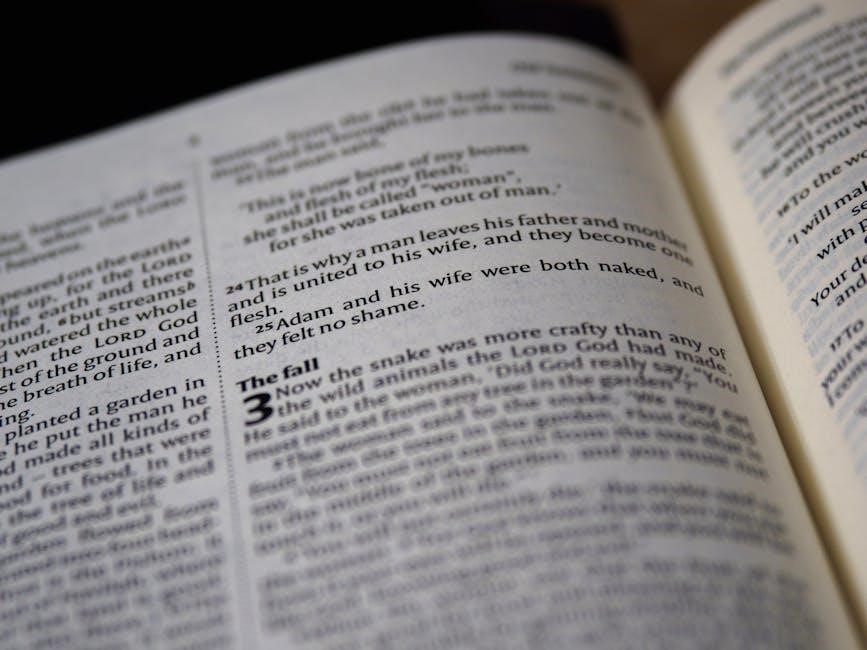
genesis to revelation bible study pdf
Explore the entire Bible with our comprehensive Genesis to Revelation Bible Study Guide. Perfect for personal or group study – download your free PDF today!
The Genesis to Revelation Bible Study PDF provides a comprehensive guide to exploring the biblical narrative, from creation to redemption. It offers insights into key themes, theological concepts, and the connection between Old and New Testaments, making it an invaluable resource for deeper faith understanding and spiritual growth.
1.1 Importance of Studying the Entire Bible
Studying the entire Bible from Genesis to Revelation provides a unified narrative of God’s plan, revealing His character, redemption, and connection between Old and New Testaments. It offers insights into Jesus’ role, theological concepts, and historical context, bridging ancient and modern life applications. This holistic approach fosters deeper faith understanding and spiritual growth, essential for grasping God’s overarching story and purpose;
1.2 Overview of Genesis to Revelation Bible Study PDF
The Genesis to Revelation Bible Study PDF is a comprehensive guide that outlines the entire Bible’s narrative, key themes, and theological insights. It includes structured lessons, visual aids, and practical applications, helping readers grasp the interconnectedness of Scripture. This resource is designed to enhance understanding and deepen spiritual growth through a systematic approach to Bible study.
Structure of the Bible
The Bible is divided into the Old Testament, containing 39 books, and the New Testament with 27 books, collectively revealing God’s plan.
2.1 The Old Testament: Genesis to Malachi
The Old Testament spans 39 books, from Genesis to Malachi, covering creation, the fall, and God’s relationship with Israel. It includes the Law, Historical Books, Wisdom Literature, and Prophets, detailing God’s covenant promises and preparation for redemption. This section establishes foundational themes and sets the stage for the New Testament, revealing God’s plan and character.
2.2 The New Testament: Matthew to Revelation
The New Testament comprises 27 books, from Matthew to Revelation, focusing on the life, teachings, death, and resurrection of Jesus Christ. It includes the Gospels, Acts, Epistles, and Revelation, detailing the establishment of the church, the spread of Christianity, and the ultimate return of Christ. Key themes include salvation, grace, and God’s ultimate plan for humanity.
2.3 Connection Between Old and New Testaments
The Old and New Testaments are intricately connected, with the latter fulfilling the promises and prophecies of the former. The Old Testament lays the foundation of God’s plan, while the New Testament reveals its culmination in Jesus Christ. Themes like covenant, redemption, and God’s sovereignty bridge both testaments, showcasing a unified story of salvation and divine purpose.

Key Themes in Genesis to Revelation
Exploring creation, humanity’s fall, God’s redemption plan, covenant promises, and ultimate restoration through Jesus Christ, revealing a unified story of divine love and salvation.
3.1 Creation and the Fall of Humanity
The Bible begins with God’s sovereign creation, establishing humanity’s purpose to glorify Him. Genesis 1-3 recounts creation, humanity’s perfection, and the fall through Adam and Eve’s disobedience, introducing sin and its consequences, shaping the need for redemption and restoring God’s original design.
3.2 God’s Plan of Redemption
God’s plan of redemption unfolds from Genesis to Revelation, addressing humanity’s sin through grace and restoration. It begins with promises to Abraham, develops through the Law and Prophets, and culminates in Jesus Christ’s sacrifice. This divine plan restores humanity’s relationship with God, offering forgiveness and eternal life, fulfilling God’s ultimate purpose of reconciliation.
3.3 The Role of Jesus Christ
Jesus Christ is the centerpiece of the Bible, fulfilling Old Testament prophecies and embodying God’s love. His life, teachings, death, and resurrection provide salvation, reconciling humanity to God. As the Messiah, Jesus restores relationships, offers forgiveness, and exemplifies God’s character, guiding believers to live according to His will and teachings, transforming lives through His grace and truth.
3.4 Visual Guide to the Bible Storyline
A visual guide to the Bible storyline provides a clear timeline of key events, connecting Genesis to Revelation. It highlights major themes, such as creation, redemption, and God’s plan, helping readers see the big picture. This tool enhances understanding by visually linking Old and New Testament events, making the Bible’s overarching narrative more accessible and engaging for deeper study.

Portrayal of Jesus in the Bible
Jesus is portrayed as the Messiah, fulfilling Old Testament prophecies and revealing God’s love through His teachings, miracles, death, and resurrection, central to humanity’s redemption.
4.1 Jesus in the Old Testament
Jesus is subtly yet profoundly foreshadowed in the Old Testament through types, symbols, and prophecies. Figures like the Passover Lamb and the bronze serpent prefigure His redeeming work. Isaiah and Micah prophesied His birth, mission, and death, while Psalms hinted at His resurrection. The Old Testament establishes Jesus as the fulfillment of God’s plan, revealing His divine nature and redemptive purpose.
4.2 Jesus in the New Testament
The New Testament fully reveals Jesus as the Messiah and Son of God. His life, teachings, miracles, death, and resurrection are detailed in the Gospels. Jesus is depicted as the Word made flesh, embodying God’s love and redemption. His sacrifice on the cross and resurrection provide salvation, fulfilling Old Testament prophecies and establishing the foundation of Christianity.

Creation Story in Genesis
Genesis recounts God’s creation of the world in six days, with rest on the seventh. Through spoken words, God brings order, forming light, land, sea, life, and humanity in His image.
5.1 Genesis 1:1 ⏤ The Beginning of Creation
Genesis 1:1 opens with God creating heaven and earth, establishing His sovereignty. This verse sets the theological foundation, revealing God as the omnipotent Creator. It introduces the theme of divine order, emphasizing God’s intentional design in forming the universe. The simplicity of the statement underscores the profound truth of God’s creative power and the origin of all existence.
5.2 Theological Insights into the Creation Account
The creation account in Genesis reveals God’s nature as a purposeful, omnipotent Creator. It establishes the distinction between God and creation, emphasizing humanity’s unique role as image-bearers of God. This narrative also introduces themes of order, stewardship, and the inherent value of creation, providing a theological foundation for understanding God’s relationship with the world and humanity’s responsibility within it.

Plan of Redemption
God’s plan of redemption unfolds from creation to consummation, addressing humanity’s sin through covenant promises, culminating in Jesus Christ’s sacrifice and ultimate restoration of all things.
6.1 From Creation to Consummation
The plan of redemption begins with creation in Genesis, where God establishes His relationship with humanity; The fall introduces sin, prompting God’s redemptive plan through covenants with Abraham, Moses, and David. Jesus Christ fulfills these promises, offering salvation through His sacrifice. The plan culminates in Revelation, where God restores creation, ushering in a new heaven and earth, completing His eternal purpose.
6.2 The Role of Sin and Salvation
Sin enters the world through humanity’s disobedience in Genesis, separating people from God. Salvation is God’s response, offering redemption through faith in Jesus Christ. The crucifixion and resurrection of Jesus provide atonement for sin, restoring humanity’s relationship with God. This narrative is central to the Bible, emphasizing God’s grace and humanity’s need for divine forgiveness and reconciliation.

Studying the Bible in a Year
A structured approach to reading the entire Bible in 12 months, covering Genesis to Revelation. This journey fosters transformation, deepens understanding, and strengthens faith through consistent study.
7.1 Genesis to Revelation Reading Plan
A well-structured plan to read the entire Bible in one year, covering daily readings from Genesis to Revelation. It divides the text into manageable parts, ensuring a logical flow and consistent progress. This approach helps readers stay organized, maintain momentum, and gain a comprehensive understanding of Scripture without feeling overwhelmed. Ideal for both new and experienced readers seeking a disciplined study routine.
7.2 Navigating the Bible in 365 Days
Navigating the Bible in 365 days requires discipline and a clear plan. By dedicating time daily, readers can systematically explore Scripture from Genesis to Revelation. Tools like timelines, summaries, and reflection prompts help maintain focus. This approach ensures a balanced pace, preventing overwhelm and fostering a deeper connection with God’s Word throughout the year.

Visual Guides and Resources
Visual guides and resources, such as charts and timelines, enhance Bible study by providing a clear and engaging overview of key events and themes.
8.1 Visual Guide to the Bible Storyline
A visual guide to the Bible storyline in the Genesis to Revelation study provides a comprehensive timeline of events, connecting key moments from creation to Christ. It includes maps, charts, and infographics to illustrate the progression of God’s plan, helping readers understand the overarching narrative and its theological significance. This tool enhances comprehension and engagement with Scripture.
8.2 Benefits of Using a Visual Guide
Using a visual guide enhances Bible study by organizing complex information into an accessible format. It improves understanding of chronological events, thematic connections, and spatial relationships. Visual tools also boost engagement, aid retention, and simplify the Bible’s vast narrative, making it easier to grasp God’s overarching plan from Genesis to Revelation.
Downloadable Bible Study Resources
Downloadable resources like the Genesis to Revelation Bible Study PDF offer comprehensive insights, making in-depth study accessible anytime, anywhere, with detailed notes and structured guidance for learners.
9.1 Genesis to Revelation Bible Course PDF
The Genesis to Revelation Bible Course PDF is a comprehensive resource designed to guide learners through the entire Bible. It features structured lessons, in-depth commentary, and visual aids like timelines and charts. Ideal for both individual and group study, this PDF provides a thorough understanding of biblical themes and their practical application to daily life, enhancing spiritual growth.
9.2 Free PDF Downloads for Bible Study
Free PDF downloads offer accessible resources for deeper Bible engagement. These materials often include study guides, devotionals, and workbooks. They cater to various learning styles, enhancing personal or group study. Many resources are designed to complement the Genesis to Revelation curriculum, providing supplementary insights and practical applications for spiritual growth and biblical understanding.

Old Testament Overview
The Old Testament spans from Genesis to Malachi, covering history, poetry, and prophecy. It includes the Law, Historical Books, Wisdom Literature, and Prophets, laying the groundwork for the New Testament.
Key themes like God’s covenant, redemption, and His relationship with Israel are central, providing a theological foundation for understanding God’s character and plan throughout Scripture.
10.1 Key Books and Themes
The Old Testament includes 39 books, divided into the Law, Historical Books, Wisdom Literature, and Prophets. Key books like Genesis, Exodus, Leviticus, and Deuteronomy establish foundational themes of creation, covenant, and redemption. Historical Books such as Joshua and Judges highlight Israel’s history, while Wisdom Literature (Psalms, Proverbs) focuses on spiritual growth and practical living. Prophets like Isaiah and Jeremiah emphasize God’s judgment and restoration, setting the stage for the New Testament.
10.2 Historical Context of the Old Testament
The Old Testament spans over 1,500 years, beginning with creation and ending with the prophets. Key historical periods include the Patriarchs (Abraham, Isaac, Jacob), Moses and the Exodus, the conquest of Canaan, the monarchy (Saul, David, Solomon), the divided kingdoms, and the Babylonian exile. These events provide the theological and cultural backdrop for understanding God’s relationship with Israel and preparation for the Messiah.
New Testament Overview
The New Testament chronicles Jesus’ life, teachings, death, and resurrection, along with the early church’s growth. It includes the Gospels, Acts, Epistles, and Revelation, revealing God’s redemptive plan through Christ.
11.1 Key Books and Themes
The New Testament includes the Gospels (Matthew, Mark, Luke, John), Acts, Epistles (Romans, Corinthians, Ephesians), and Revelation. Key themes are salvation, grace, faith, and the Kingdom of God. The Gospels focus on Jesus’ life, teachings, death, and resurrection. Epistles provide theological depth and practical guidance for believers. Revelation concludes with eschatology and God’s ultimate triumph.
11.2 The Life and Teachings of Jesus Christ
Jesus’ life and teachings are central to the New Testament. His ministry emphasized love, forgiveness, and the Kingdom of God. Key events include His miracles, parables, and the Great Commission. Jesus’ teachings highlighted humility, compassion, and obedience to God’s will. His death and resurrection are the cornerstone of Christian faith, offering salvation and eternal life to humanity.

Theological Concepts
The Bible explores profound theological ideas, including God’s sovereignty, grace, and humanity’s relationship with Him; These themes form the foundation of Christian theology and faith.
12.1 The Nature of God in the Bible
The Bible reveals God as both transcendent and immanent, showcasing His sovereignty and personal involvement. From Genesis to Revelation, God is depicted as omnipotent, loving, just, holy, and merciful. His nature is consistent, yet multifaceted, emphasizing His grace and redemption plan for humanity, which underscores His unchanging character and divine purpose.
12.2 The Concept of Redemption
The concept of redemption is central to the Bible, highlighting God’s plan to restore humanity from sin. From the Fall in Genesis to Christ’s sacrifice, redemption is a continuous theme. It involves divine forgiveness, deliverance, and restoration, culminating in Jesus’ death and resurrection, which offers humanity salvation and eternal life through faith.

Modern Tools for Bible Study
Modern tools like Bible study apps, e-books, and online platforms enhance learning, offering interactive features, study notes, and accessible resources for deeper engagement with Scripture anywhere.
13.1 Bible Study Apps and Software
Bible study apps and software, like YouVersion and Logos, offer interactive tools, study notes, and resources to deepen understanding. Features include verse-by-verse commentary, maps, and note-taking, enhancing the Genesis to Revelation study experience. They provide accessible and organized ways to explore Scripture, making it easier to connect themes and verses for a comprehensive biblical understanding. These tools cater to both individual and group study formats effectively.
13.2 Online Resources for Deep Study
Online resources like BibleGateway and BlueLetterBible provide in-depth study tools, including commentaries, original languages, and study notes. Websites such as GotQuestions offer detailed answers, while PreceptAustin provides historical context. These platforms enrich the Genesis to Revelation study by offering accessible, comprehensive materials for analyzing themes, timelines, and theological concepts effectively.
Practical Application
Practical application involves integrating biblical truths into daily life, fostering spiritual growth through prayer, service, and community engagement. Daily reflection and obedience to God’s Word are essential.
14.1 Applying Biblical Teachings to Daily Life
Applying biblical teachings to daily life involves integrating spiritual truths into practical actions. This includes making ethical decisions, fostering healthy relationships, and demonstrating compassion. By studying Genesis to Revelation, believers gain wisdom to navigate life’s challenges, aligning their actions with God’s will and promoting personal and communal transformation through faith-inspired living.
14.2 The Role of Community in Bible Study
Community plays a vital role in Bible study by fostering accountability, encouragement, and collective growth. Group discussions and shared insights deepen understanding, while mutual support strengthens faith. Prayer and collaboration within a community context enhance spiritual journeys, creating a unified body of believers striving together to apply biblical truths in their lives effectively.
The journey from Genesis to Revelation reveals God’s plan of creation, redemption, and eternal life through Jesus Christ. Embrace continued study for deeper spiritual growth.
15.1 Summary of Key Takeaways
The Genesis to Revelation Bible study PDF provides a comprehensive journey through Scripture, highlighting creation, the fall, redemption, and Jesus’ role as Savior. It emphasizes God’s sovereignty, grace, and the interconnectedness of the Old and New Testaments. Practical application and community engagement are encouraged to deepen understanding and live out biblical truths effectively in daily life.
15.2 Encouragement for Continued Study
Embrace the journey of studying God’s Word with perseverance and passion. Deepen your faith by consistently exploring the Genesis to Revelation Bible study PDF. Seek God’s truth, allowing it to transform your life and strengthen your relationship with Him. Stay committed, pray for wisdom, and engage with a community to enhance your understanding and growth in Scripture.